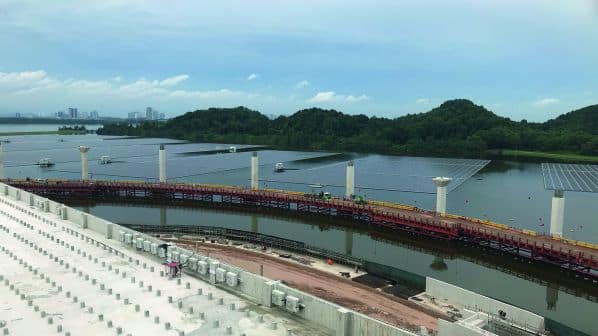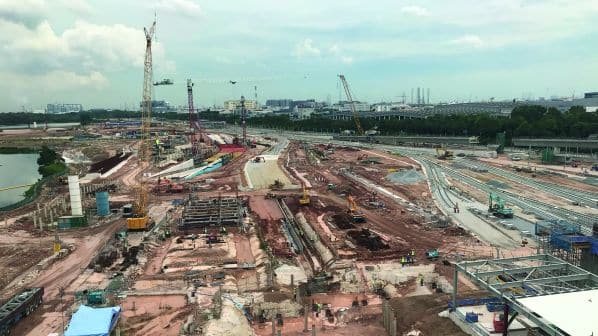ONCE a haven for golfers of the Raffles Country Club, a 50ha site in western Singapore is on course to become a leading railway research and testing facility for the city’s metro rail network. Construction of the new Integrated Train Testing Centre (ITTC) is now more than 50% complete and testing of the first trains will commence in 2023.
Tracklaying of the new 3km high-speed test track was due to be completed by the end of 2022. Three new trains supplied by Alstom for the Circle Line extension will be the first to use the 100km/h straight test track. This track is fitted will be able to test two trains when full operation commences in 2023.
A visit to the site by IRJ in November revealed progress with construction of the wider facility. Work to erect the shell of the new 205m by 106m eight-track maintenance hall is well underway and the roof is on schedule to be completed in the first quarter this year. Construction of the new three-storey operations control centre (OCC) and a three-storey administration building are also progressing well and are expected to be in full operation in 2025.
The view from the top of the OCC revealed that the 3km endurance and the 2.8km performance and integration tracks are taking shape. The latter features a maximum gradient of 3% and the elevated section includes a 500m section built across 12 piers constructed within the adjacent reservoir in order to provide a 190m curve on the test loop. A special construction method was deployed for the piers in which pre-cast concrete elements were installed on the water to offer a water-tight shell in which the pier’s foundations could be installed without contaminating the water. The performance and integration track includes an S curve section which will be used to test train dynamics. It also has a maximum curve radius of 140m.
Each of the test tracks will be equipped with the various signalling, telecommunications, control and 1500V dc overhead and 750V dc third rail electrification systems used across the Singapore metro network. Of the 16.9km of track at the facility, 2.7km is elevated.
“The location is also ideal because it is away from residents, I can test 24/7 if I need to, without inconveniencing the public.”
LTA deputy CEO, Mr Chua Chong Kheng
The Land Transport Authority (LTA) secured the land as part of the procurement process for the now abandoned Singapore - Kuala Lumpur high-speed project. The high-speed rail alignment ran across the land from southwest to northeast, but the authority was asked to make full use of the entire 100ha site. It will build a new rolling stock depot for the Cross Island Line on the other 50ha portion of land.
LTA deputy CEO, Mr Chua Chong Kheng, says the government asked LTA whether it could use the remaining land after it became clear the high-speed rail project would not move ahead. He reveals in a moment of inspiration, the possibility of building the testing facility was raised, as it was always a challenge to have to test new trains and systems in Singapore. “The location is also ideal because it is away from residents,” Chua says. “I can test 24/7 if I need to, without inconveniencing the public.”
Design-build contract
LTA awarded GS Engineering & Construction (GS E&C), Korea a design-build contract worth $S 639.5m ($US 451.6m) in April 2020. Design support was provided by Arup (mechanical and electrical engineering) and Ong & Ong (architectural). The overall budget is around $S 1bn.
GS E&C is supported by the Korean Railroad Research Institute (KRRI), which is drawing on experience from its Osong train testing facility in central Korea, which opened in June 2019. LTA has also partnered with Siemens, the owner and operator of the Wildenrath test facility in northwest Germany.
Chua says ITTC will limit the need to conduct both new and existing rolling stock testing during constrained engineering hours. A maximum of 3 hours is available on an operating line when the network is usually closed for maintenance. Railway systems and trains testing also typically take place over sections of line for a longer period of time, preventing the operator from carrying out maintenance while these tests take place. Chua says ITTC will offer the advantage of offline testing with the actual trains and wayside systems, facilitating efficient and effective troubleshooting and offering the ability to re-test the trains and systems post-rectification with minimal disruption to everyday maintenance or services.

“Singaporeans these days have very high expectations,” Chua says. “You deploy a new vehicle or railway system and the expectation is that it must function perfectly from day one. But it is never the case because the rolling stock and railway systems are complicated systems with a high degree of integration and include numerous hardware and software. The limited testing slots and time available on the operational line makes the task even more daunting.”
He adds that what will set ITTC apart from other testing facilities is its focus on both rolling stock and systems testing, Multiple trains and systems will be tested concurrently at ITTC.
“Everything must work as a coherent system as designed, both during normal and degraded modes of operation, especially with our GoA4, fully automated metro,” Chua says.
Certainly, the ability to test all manner of failure modes will provide insight on asset performance not previously possible, helping operators SMRT and SBS Transit to achieve ambitious operational targets and help to facilitate the use of predictive maintenance regimes. It will also help to sustain the overall high level of performance of the metro systems required to meet increasing demand.
Use by third parties is also foreseen in the long term with the centre poised to become a specialist train testing facility for Southeast Asia and beyond.
Progress with construction has been swift. And if work continues to proceed to schedule, full operation of the facility will commence in mid-2025, opening the latest chapter in Singapore’s impressive railway journey.
“It’s a big investment on the part of government and it wasn’t an easy task to make the case with the relevant ministries,” Chua says. “But if we look at overall investment in the ITTC as a proportion of the around $S 100bn spent on our overall metro network, and the immense benefits in terms of the high railway reliability that the ITTC will help to achieve, this is a worthwhile investment.”

